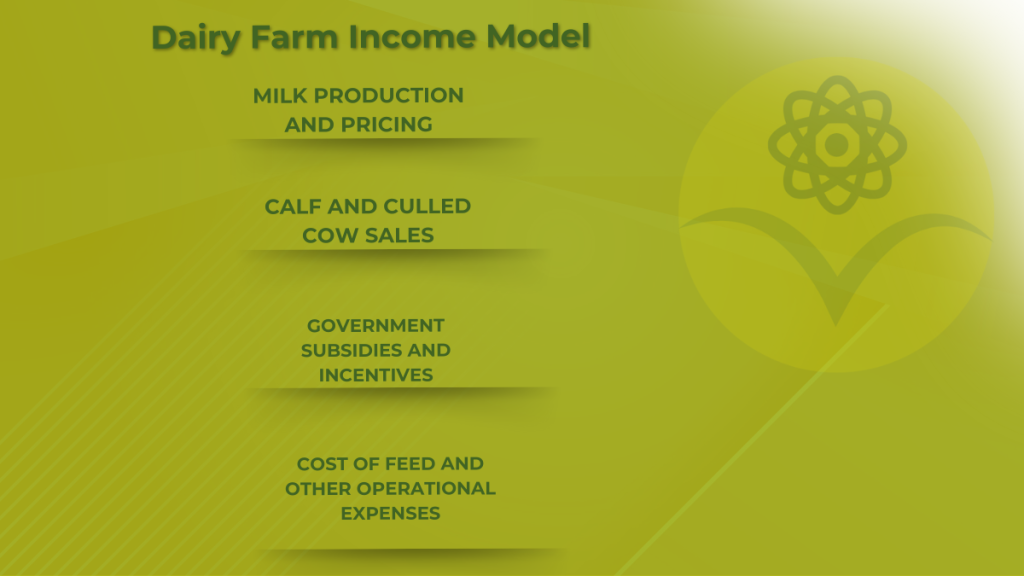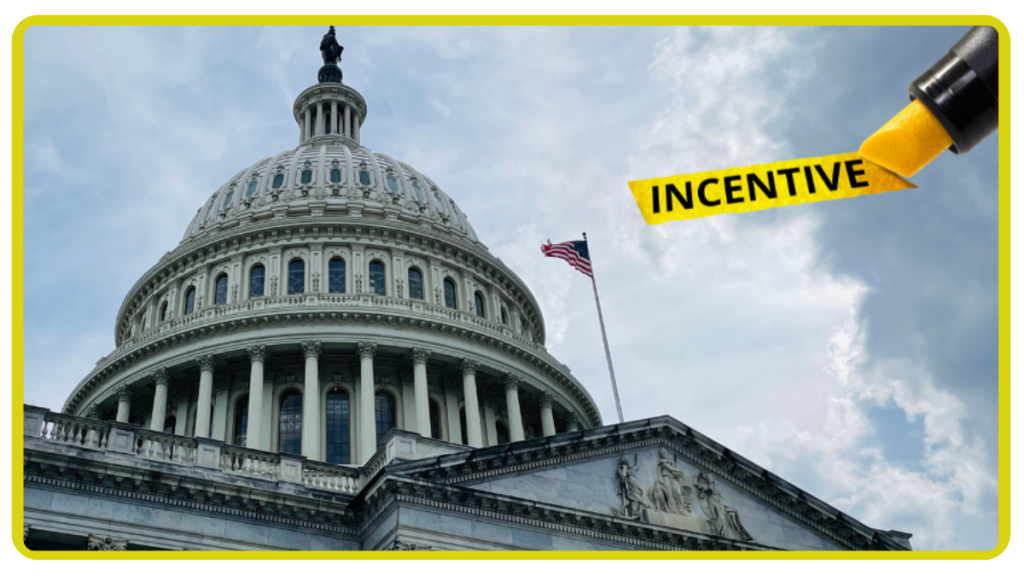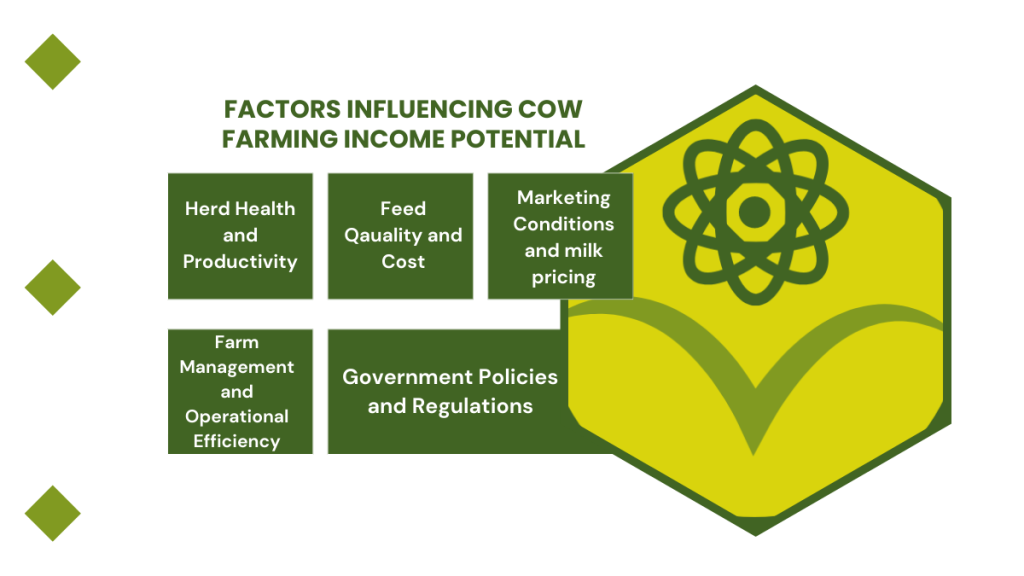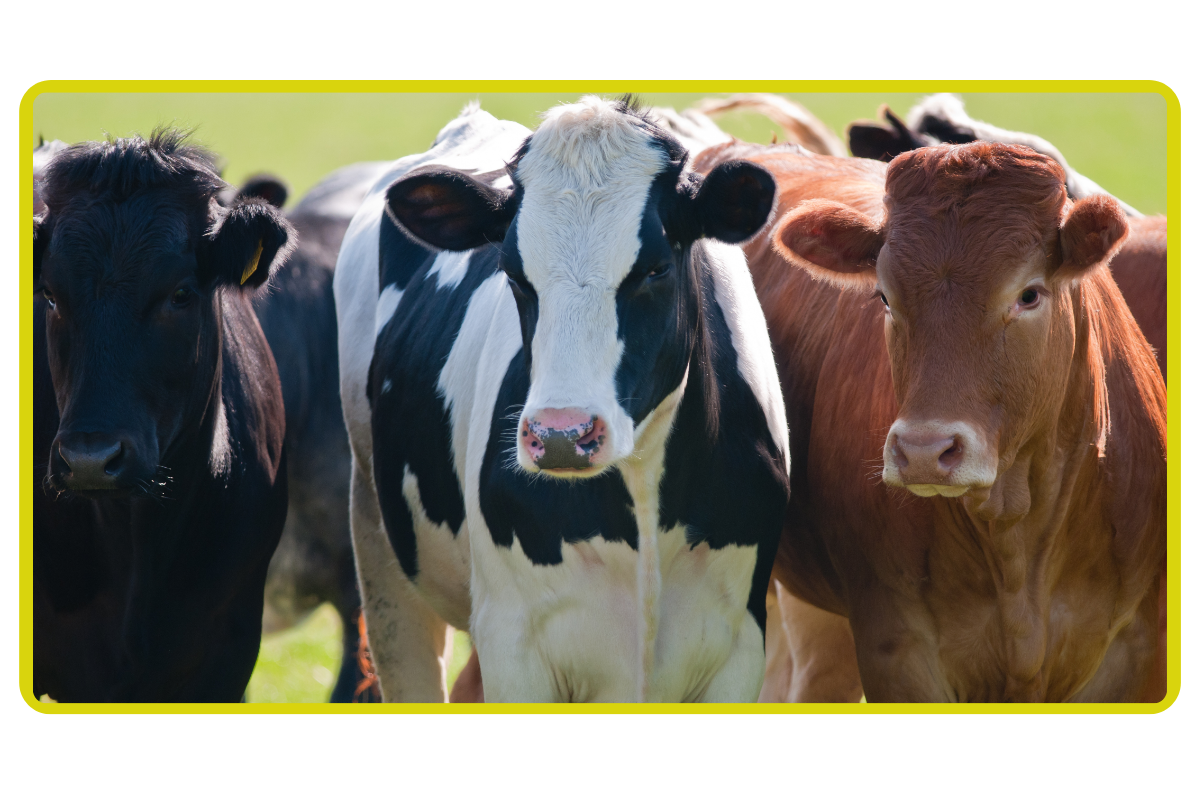Dairy farming is a complex and multifaceted industry, with a wide range of factors influencing the Dairy Farm Income potential and success.
As a prospective or current dairy farmer, understanding the income potential of a small-scale operation, such as a 10-cow dairy farm, is crucial in making informed decisions and planning for a sustainable future.
10 Cows Dairy Farm Income
In this comprehensive blog post, we will explore the various revenue streams, expenses, and potential profit margins associated with a 10-cow dairy operation.
Whether you’re considering venturing into the dairy industry or looking to optimize the performance of your existing farm, this in-depth analysis will provide you with valuable insights to help you navigate the path to financial success.
Understanding the Dairy Farm Income Model
The income potential of a 10-cow dairy farm is primarily driven by the following key factors:
- Milk Production and Pricing
- Calf and Culled Cow Sales
- Government Subsidies and Incentives
- Cost of Feed and Other Operational Expenses

Let’s delve into each of these factors in detail to gain a comprehensive understanding of the income potential.
Milk Production and Pricing
The foundation of a dairy farm’s income is the sale of milk.
The average annual milk production per cow can vary depending on factors such as breed, feed quality, and herd management practices.
For the purpose of this analysis, let’s assume an average annual milk production of 6,000 gallons per cow.
The price received for the milk is another crucial component.
Milk prices can fluctuate based on various market conditions, including supply and demand, government regulations, and global trade.
According to the latest industry data, the average price for raw milk in the United States is around $18 per hundredweight (cwt), or approximately $1.80 per gallon.
Using these assumptions, the total annual milk revenue for a 10-cow dairy farm can be calculated as follows:
- Milk Production per Cow: 6,000 gallons
- Total Milk Production (10 cows): 60,000 gallons
- Milk Price per Gallon: $1.80
- Total Milk Revenue: $108,000
Calf and Culled Cow Sales
In addition to milk sales, dairy farmers can generate additional income from the sale of calves and culled cows.
Calf Sales: Dairy cows typically give birth to one calf per year.
Assuming a 90% calf survival rate, a 10-cow dairy farm would have the potential to sell approximately 9 calves per year.
The average price for a dairy calf can range from $300 to $500, depending on factors such as breed, gender, and market conditions. For this analysis, let’s assume an average calf sale price of $400.
- Calf Sales (9 calves x $400 per calf): $3,600
Culled Cow Sales: Dairy cows have a productive lifespan of approximately 5-7 years.
Over time, some cows may need to be culled from the herd due to health issues, low milk production, or other factors.
Assuming a 20% annual culling rate, a 10-cow dairy farm would have the potential to sell 2 culled cows per year.
The average price for a culled dairy cow can range from $800 to $1,200, depending on the animal’s weight and condition.
Let’s assume an average culled cow sale price of $1,000.
- Culled Cow Sales (2 cows x $1,000 per cow): $2,000
The total annual revenue from calf and culled cow sales would be:
- Calf Sales: $3,600
- Culled Cow Sales: $2,000
- Total Calf and Culled Cow Sales: $5,600
Government Subsidies and Incentives
Dairy farmers in the United States may be eligible for various government subsidies and incentive programs, which can provide an additional revenue stream.
These programs are designed to support the dairy industry and help farmers navigate market fluctuations and economic challenges.

Some common government programs that dairy farmers may be able to access include:
Dairy Margin Coverage (DMC) Program: This program provides financial assistance to dairy farmers when the difference between the all-milk price and the feed cost falls below a certain threshold.
Dairy Indemnity Payment Program (DIPP): This program compensates dairy farmers for milk or dairy products that have been removed from commercial markets due to chemical, nuclear, or other contamination.
Environmental Quality Incentives Program (EQIP): This program provides financial and technical assistance to dairy farmers to implement conservation practices that improve soil, water, plant, animal, air, and related natural resources on their land.
The availability and eligibility criteria for these programs can vary depending on the location and specific circumstances of the dairy farm.
For this analysis, let’s assume a conservative estimate of $5,000 in annual government subsidies and incentives for the 10-cow dairy farm.
Cost of Feed and Other Operational Expenses
The primary expense for a dairy farm is the cost of feed, which can account for 50-70% of the total operational costs.
Other significant expenses include veterinary care, breeding, utilities, labor, and equipment maintenance.
Here’s a breakdown of the estimated annual expenses for a 10-cow dairy farm:
- Feed Costs (60% of total expenses): $60,000
- Veterinary Care: $5,000
- Breeding Costs: $2,000
- Utilities (electricity, water, etc.): $6,000
- Labor: $15,000
- Equipment Maintenance: $8,000
- Other Miscellaneous Expenses: $4,000
- Total Annual Expenses: $100,000
Calculating the Income Potential
Now that we have a clear understanding of the key revenue streams and expenses, let’s calculate the potential income for a 10-cow dairy farm:
- Total Annual Revenue:
- Milk Sales: $108,000
- Calf and Culled Cow Sales: $5,600
- Government Subsidies and Incentives: $5,000
- Total Annual Revenue: $118,600
- Total Annual Expenses: $100,000
- Potential Annual Net Income: $118,600 – $100,000 = $18,600
Based on the assumptions and calculations provided, the potential annual net income for a 10-cow dairy farm is approximately $18,600.
It’s important to note that these figures are estimates and can vary depending on a variety of factors, such as:
- Actual milk production and pricing
- Calf and culled cow sale prices
- Availability and amount of government subsidies and incentives
- Fluctuations in feed costs and other operational expenses
Additionally, dairy farming involves significant upfront investments, such as the purchase of land, buildings, equipment, and the initial herd.
These capital costs are not included in the income potential calculation but should be carefully considered when evaluating the overall feasibility and profitability of a 10-cow dairy farm.
Factors Influencing Income Potential
To further understand the income potential of a 10-cow dairy farm, it’s essential to explore the key factors that can impact the overall financial performance.

Herd Health and Productivity
The health and productivity of the dairy herd are critical in maximizing milk production and revenue.
Factors such as breeding, nutrition, and veterinary care can significantly influence the cows’ milk yield, reproductive performance, and longevity.
Maintaining a healthy and productive herd is essential for optimizing the farm’s income potential.
Feed Quality and Cost
Feed costs are the largest expense for a dairy farm, and the quality and cost of feed can have a significant impact on the bottom line.
Investing in high-quality, nutrient-dense feed can improve the cows’ health, milk production, and feed efficiency, ultimately enhancing the farm’s profitability.
Monitoring feed prices and exploring cost-saving strategies, such as on-farm feed production, can also help manage this critical expense.
Market Conditions and Milk Pricing
Fluctuations in the dairy market, including changes in milk prices, can significantly affect the farm’s income potential.
Staying informed about market trends, negotiating favorable milk contracts, and exploring alternative revenue streams (e.g., value-added dairy products) can help mitigate the impact of market volatility.
Farm Management and Operational Efficiency
Effective farm management and operational efficiency are crucial in maximizing the income potential of a 10-cow dairy farm.
This includes optimizing herd management practices, implementing cost-saving measures, and exploring opportunities to diversify the farm’s revenue streams.
Government Policies and Regulations
The dairy industry is heavily influenced by government policies, regulations, and support programs.
Changes in these areas, such as shifts in subsidies or environmental regulations, can have a direct impact on the farm’s income potential.
Staying informed and adaptable to policy changes is essential for dairy farmers to maintain profitability.
Strategies for Maximizing Income Potential
To optimize the income potential of a 10-cow dairy farm, consider the following strategies:

Focus on Herd Health and Productivity: Invest in high-quality veterinary care, breeding programs, and nutrition to ensure the cows are healthy, productive, and able to reach their full milk-producing potential.
Implement Cost-Saving Measures: Explore opportunities to reduce feed costs, such as on-farm feed production or negotiating better prices with suppliers. Additionally, implement energy-efficient practices and optimize equipment and labor utilization to lower operational expenses.
Diversify Revenue Streams: Consider adding value-added products, such as artisanal cheeses or yogurt, to your product offerings. This can help you capture a larger share of the consumer market and increase your overall revenue.
Stay Informed and Adaptable: Closely monitor market conditions, government policies, and industry trends to identify opportunities and mitigate risks. Be prepared to adjust your operations and strategies as needed to maintain profitability.
Leverage Government Subsidies and Incentives: Actively research and apply for relevant government programs that can provide financial assistance and support for your dairy farm.
Continuously Improve Farm Management: Regularly review and optimize your herd management, feed practices, and overall operational efficiency to identify areas for improvement and enhance the farm’s profitability.
Considering the dairy financial performance, according to the Economic Research Service U.S. Department of Agriculture, larger U.S. dairy farms tend to be more profitable than smaller ones.
Conclusion
The income potential of a 10-cow dairy farm is a complex and multifaceted topic, with a wide range of factors influencing the overall financial performance.
By understanding the key revenue streams, expenses, and strategies for maximizing profitability, dairy farmers can make informed decisions and take the necessary steps to unlock the full potential of their operations.
Whether you’re a seasoned dairy farmer or considering venturing into the industry, this comprehensive analysis provides valuable insights to help you navigate the path to a successful and sustainable 10-cow dairy farm.
By focusing on herd health, cost management, revenue diversification, and continuous improvement, you can position your farm for long-term financial success and contribute to the vibrant dairy industry.
Explore The Dairy Farming Environmental Impact.

